Apple's 15-inch Core i5 MacBook Pro: The One to Get?
by Anand Lal Shimpi on April 14, 2010 10:38 PM EST- Posted in
- Mac
- MacBook Pro
- Arrandale
- Core i5
- Laptops
They’re Actually Faster
Benchmarking under OS X isn’t difficult, you just need to get creative. Luckily I’m in dire need of creative outlets so creating OS X benchmarks works for me. I’m using the same tests I introduced in my Holiday 2009 Macbook Pro roundup and running on the same hardware (specs listed in the tables on the previous pages). The Core i5 system is the new entry level 15-inch MacBook Pro.
We’ll start with general application performance.
General OS usage is a difficult thing to quantify, but one measure of performance has always been the number of bounces an icon in the dock makes before an application loads. I decided to take it to the next level and write a quick script to launch 15 applications in a row, timing how long the entire process takes.
I launched, in order: Mail, Safari, Activity Monitor, iTunes, iCal, DVD Player, iPhoto, Photo Booth, Quicktime Player, Disk Utility, Preview, iMovie, Front Row, Garage Band and Aperture.
The entire process stresses both the disk and CPU, which is why we see a huge improvement when going to an SSD as well as differences between CPU speeds.
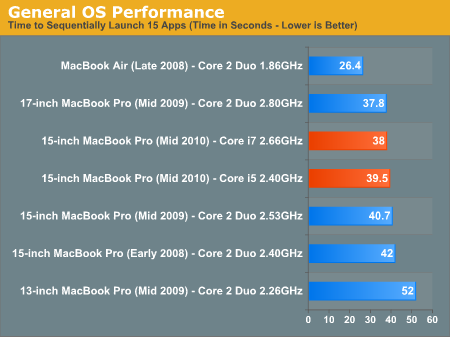
My application launch test absolutely rocks on the MacBook Air because it ships with an SSD by default. The MacBook Pros are stuck with mechanical hard drives and thus don’t perform nearly as well. If you’re curious, installing an Intel X25-M G2 in any of the MBPs will drop their times to 16 seconds or less.
The new MacBook Pro also doesn’t improve performance that much. I measured a 3% increase in performance, which although repeatable, isn’t really spectacular. This is compared to the old 2.53GHz Core 2 Duo and should serve as a baseline for the minimum performance improvement you should see. In other words, the 2.4GHz 15-inch MacBook Pro should perform no worse than last year’s 2.53GHz model.
The $2199 model with a Core i7 running at 2.66GHz pushes performance up another 3.9% over the base model. That's actually more than I expected but the real strength of the i7 is visible in the more CPU bound tests.
Adobe Photoshop CS4 Performance
The Retouch Artists Speed Test we use for our CPU testing under Windows also works under OS X. We're running the exact same benchmark here, basically performing a bunch of image manipulations and filters and timing the entire process.
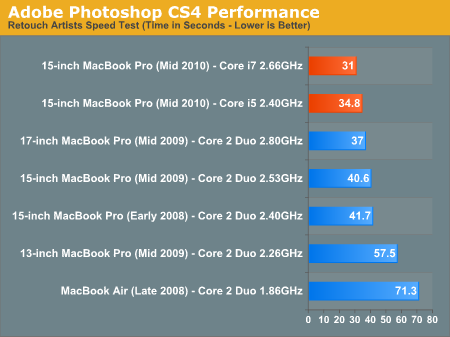
The old 13-inch MacBook Pro is penalized by only shipping with 2GB of memory, which is why it performs so poorly here. The real comparison is between the 2.4GHz Core i5 vs. the 2.53GHz Core 2 Duo from last year. The former is 16.6% faster in our Photoshop test. In fact, the new 15-inch MacBook Pro is even faster than the older 2.80GHz 17-inch model I reviewed.
The Core i7 model is 12.3% faster than the baseline Core i5 2.40GHz. Definitely noticeable.
Aperture 2 RAW Import
For my Aperture test I simply timed how long it took to import 203 12MP RAW images into the library.
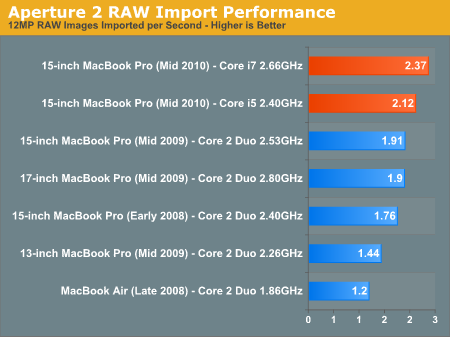
The new entry level 15-inch MBP is 10.9% faster than the old MacBook Pro, and again, it’s faster than the old 17-inch model as well. Moving to the Core i7 gives you another 11.8%.
Cinebench R10
I’m a fan of the Cinebench test because it lets me show off both single and multithreaded performance in the same workload. First, the single threaded performance:
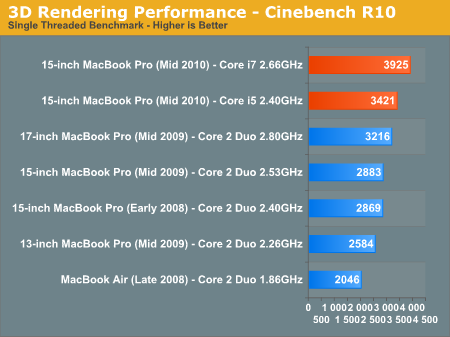
Here we have a huge advantage on the new MacBook Pro. Intel’s Turbo Boost is active here, resulting in a large performance advantage, not to mention all of the enhancements present in the Nehalem/Arrandale architectures. This is one of the best situations for the Core i7 vs. the i5. The extra $400 gives you another 14.7%, not bad at all.
Multithreaded performance is equally impressive:
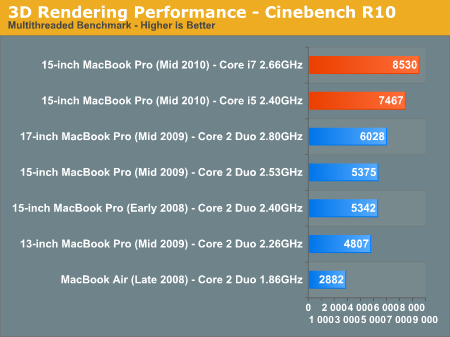
Thanks to Hyper Threading, the new Core i5 puts a generational gap between itself and last year’s MacBook Pro in this test. Whether you’re running single threaded or multithreaded applications, the Core i5 can be noticeably faster than the Core 2 Duo.
Quicktime H.264 Video Encoding
Our final benchmark is more consumer focused. Here I'm taking an XviD and converting it to an iPhone-supported H.264 format.
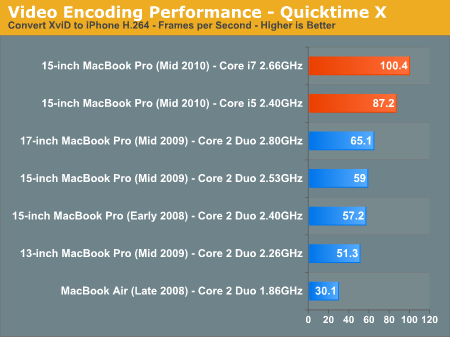
Video encoding is one of the i5’s definite strengths. If you do a lot of video encoding on your notebook, the jump from Core 2 to i5 is tremendous - approaching 50% in this case even despite the “lower” default clock speed. This is also the best showing for the Core i7 - count on an extra 15% over the base Core i5.
Core i7 vs. Core i5 Performance Summary
The two Core i5 models Apple offers ship with a 2.40GHz or 2.53GHz processor, both with a 3MB L3 cache. The $2199 15-inch MacBook Pro comes with a 2.66GHz Core i7, with a full 4MB L3 cache. Compared to the entry level model that's an 11% increase in clock speed and a 33% increase in L3 cache.
While I don't believe there's much reason to go for the 2.53GHz over the 2.40GHz model (L3 cache size remains the same, clock speed goes up by a small amount), the Core i7 is actually pretty decent. For a 22% increase in total system cost you end up with 11 - 15% better performance in CPU bound applications. It actually even feels snappier in general use as well.
I'd still suggest opting for an SSD before considering any CPU upgrades, but if you're looking to keep your new MacBook Pro for a while the Core i7 is worth it.










114 Comments
View All Comments
MySchizoBuddy - Wednesday, April 14, 2010 - link
sorry i was looking at the 620UM. someone needs more clearer namesAffectionate-Bed-980 - Wednesday, April 14, 2010 - link
seriously? Didn't the 15" get the 9600GT in the two higher level ones?The 9400M was a 13" MBP model and also for the base 15". But clearly the 330M GT is designed to replace the 9600M GT not the 9400M. The 320M GT now in the 13" MBPs is designed to replace the 9400M. The base 15" MBP got an upgrade this year from 9400M to 330M GT, but it's clearly two different classes.
I would've preferred if you benched the 330M GT against the 9600M GT which was an upgrade to the old 8600M GT that I have from an early 2008 MBP. The 9400M is just the wrong card to bench against.
Affectionate-Bed-980 - Wednesday, April 14, 2010 - link
so yes, it's obvious the 330 will be faster than the 9400, but how much faster than the 9600? I think that's the most crucial question.The 320 should've been pitted against the 9400 and 330 against 9600.
Anand Lal Shimpi - Wednesday, April 14, 2010 - link
I agree, I just don't have any of the MBPs with the 9600M around the lab anymore :)Take care,
Anand
Affectionate-Bed-980 - Thursday, April 15, 2010 - link
aww how unfortunate. I just figured that since you put the 2.53 ghz MBP in comparison that it would be the 9600M one. Oh well. I'm glad you at least included my 2008 MBP in the benches (way to make me feel like I need to upgrade :D )Great review
Anand Lal Shimpi - Thursday, April 15, 2010 - link
I always try to have at least n-2 generations of MacBook Pro hardware laying around for comparisons like this :)Take care,
Anand
youguy - Wednesday, April 14, 2010 - link
With SSDs offered as an option, why aren't we seeing TRIM support in Snow Leopard?Griswold - Thursday, April 15, 2010 - link
Ask steve@apple.comShould he respond, it might be something along the line of "We dont believe people want to trim anything". Or that SSDs "are a mess".
Good luck.
ggathagan - Thursday, April 15, 2010 - link
Battery life would be my guess.To a lesser extent, I suppose a 5400rpm drive also generates less heat than a 7200, but I don't know if the difference would be significant.
Brian Klug - Thursday, April 15, 2010 - link
You know, that used to be my thought as well, and I was totally concerned back when the first notebook form factor 7200 RPM drives swung around, but there's no truth to those assumptions anymore. In fact, back then I found that the newer 7kRPM drive actually gave me *better* battery life and reported cooler temps through SMART. Not sure how, but that's just how it worked out. Obviously there are going to be small differences, but there's also that HUGI (hurry up and get idle) consideration to be made here the same way intel rationalizes turbo mode on a notebook; get the task done fast, then go into a low power state. It ends up being a net energy savings.But it's obvious that heat/battery aren't the real reasons; the 7K RPM drives are still options, just not default. $50 isn't that much for a "pro" notebook is my point.
At the same point, a platter drive is a platter drive; the performance gains aren't going to be anywhere near what you'll see with an SSD, so perhaps it makes more sense to just forget about upgrading the HDD and save the $50 for your SSD. There are arguments for both I suppose.
-Brian